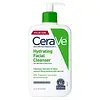What's inside
What's inside
 Key Ingredients
Key Ingredients

 Benefits
Benefits

 Concerns
Concerns

 Ingredients Side-by-side
Ingredients Side-by-side

Water
Skin ConditioningGlycerin
HumectantCetearyl Alcohol
EmollientPEG-40 Stearate
EmulsifyingStearyl Alcohol
EmollientPotassium Phosphate
BufferingCeramide NP
Skin ConditioningCeramide AP
Skin ConditioningCeramide EOP
Skin ConditioningCarbomer
Emulsion StabilisingGlyceryl Stearate
EmollientBehentrimonium Methosulfate
Sodium Lauroyl Lactylate
EmulsifyingSodium Hyaluronate
HumectantCholesterol
EmollientPhenoxyethanol
PreservativeDisodium EDTA
Dipotassium Phosphate
BufferingTocopherol
AntioxidantPhytosphingosine
Skin ConditioningXanthan Gum
EmulsifyingCetyl Alcohol
EmollientPolysorbate 20
EmulsifyingEthylhexylglycerin
Skin ConditioningWater, Glycerin, Cetearyl Alcohol, PEG-40 Stearate, Stearyl Alcohol, Potassium Phosphate, Ceramide NP, Ceramide AP, Ceramide EOP, Carbomer, Glyceryl Stearate, Behentrimonium Methosulfate, Sodium Lauroyl Lactylate, Sodium Hyaluronate, Cholesterol, Phenoxyethanol, Disodium EDTA, Dipotassium Phosphate, Tocopherol, Phytosphingosine, Xanthan Gum, Cetyl Alcohol, Polysorbate 20, Ethylhexylglycerin
Kaolin
AbrasiveOryza Sativa Powder
Dicalcium Phosphate
AbrasiveSodium Methyl Cocoyl Taurate
CleansingWater
Skin ConditioningSodium Cocoyl Isethionate
CleansingOlea Europaea Fruit Oil
MaskingSodium Cocoyl Glycinate
CleansingSodium Chloride
MaskingTremella Fuciformis Sporocarp Extract
AntioxidantAcer Saccharum Extract
Skin ConditioningSaccharomyces/Rice Ferment Filtrate
Skin ConditioningSaccharum Officinarum Extract
MoisturisingTocopherol
AntioxidantAllantoin
Skin ConditioningVaccinium Myrtillus Fruit Extract
Skin ConditioningBetaine
HumectantCitrus Aurantium Dulcis Fruit Extract
MaskingCitrus Limon Fruit Extract
MaskingGeranium Robertianum Extract
AstringentCoconut Acid
CleansingGlycerin
HumectantHeterotheca Inuloides Flower Extract
MaskingButylene Glycol
HumectantPhenoxyethanol
PreservativePotassium Sorbate
PreservativeSodium Dehydroacetate
PreservativeEthylhexylglycerin
Skin ConditioningKaolin, Oryza Sativa Powder, Dicalcium Phosphate, Sodium Methyl Cocoyl Taurate, Water, Sodium Cocoyl Isethionate, Olea Europaea Fruit Oil, Sodium Cocoyl Glycinate, Sodium Chloride, Tremella Fuciformis Sporocarp Extract, Acer Saccharum Extract, Saccharomyces/Rice Ferment Filtrate, Saccharum Officinarum Extract, Tocopherol, Allantoin, Vaccinium Myrtillus Fruit Extract, Betaine, Citrus Aurantium Dulcis Fruit Extract, Citrus Limon Fruit Extract, Geranium Robertianum Extract, Coconut Acid, Glycerin, Heterotheca Inuloides Flower Extract, Butylene Glycol, Phenoxyethanol, Potassium Sorbate, Sodium Dehydroacetate, Ethylhexylglycerin
 Reviews
Reviews

Ingredients Explained
These ingredients are found in both products.
Ingredients higher up in an ingredient list are typically present in a larger amount.
Ethylhexylglycerin (we can't pronounce this either) is commonly used as a preservative and skin softener. It is derived from glyceryl.
You might see Ethylhexylglycerin often paired with other preservatives such as phenoxyethanol. Ethylhexylglycerin has been found to increase the effectiveness of these other preservatives.
Glycerin is already naturally found in your skin. It helps moisturize and protect your skin.
A study from 2016 found glycerin to be more effective as a humectant than AHAs and hyaluronic acid.
As a humectant, it helps the skin stay hydrated by pulling moisture to your skin. The low molecular weight of glycerin allows it to pull moisture into the deeper layers of your skin.
Hydrated skin improves your skin barrier; Your skin barrier helps protect against irritants and bacteria.
Glycerin has also been found to have antimicrobial and antiviral properties. Due to these properties, glycerin is often used in wound and burn treatments.
In cosmetics, glycerin is usually derived from plants such as soybean or palm. However, it can also be sourced from animals, such as tallow or animal fat.
This ingredient is organic, colorless, odorless, and non-toxic.
Glycerin is the name for this ingredient in American English. British English uses Glycerol/Glycerine.
Learn more about GlycerinPhenoxyethanol is a preservative that has germicide, antimicrobial, and aromatic properties. Studies show that phenoxyethanol can prevent microbial growth. By itself, it has a scent that is similar to that of a rose.
It's often used in formulations along with Caprylyl Glycol to preserve the shelf life of products.
Tocopherol (also known as Vitamin E) is a common antioxidant used to help protect the skin from free-radicals and strengthen the skin barrier. It's also fat soluble - this means our skin is great at absorbing it.
Vitamin E also helps keep your natural skin lipids healthy. Your lipid skin barrier naturally consists of lipids, ceramides, and fatty acids. Vitamin E offers extra protection for your skin’s lipid barrier, keeping your skin healthy and nourished.
Another benefit is a bit of UV protection. Vitamin E helps reduce the damage caused by UVB rays. (It should not replace your sunscreen). Combining it with Vitamin C can decrease sunburned cells and hyperpigmentation after UV exposure.
You might have noticed Vitamin E + C often paired together. This is because it is great at stabilizing Vitamin C. Using the two together helps increase the effectiveness of both ingredients.
There are often claims that Vitamin E can reduce/prevent scarring, but these claims haven't been confirmed by scientific research.
Learn more about TocopherolWater. It's the most common cosmetic ingredient of all. You'll usually see it at the top of ingredient lists, meaning that it makes up the largest part of the product.
So why is it so popular? Water most often acts as a solvent - this means that it helps dissolve other ingredients into the formulation.
You'll also recognize water as that liquid we all need to stay alive. If you see this, drink a glass of water. Stay hydrated!
Learn more about Water